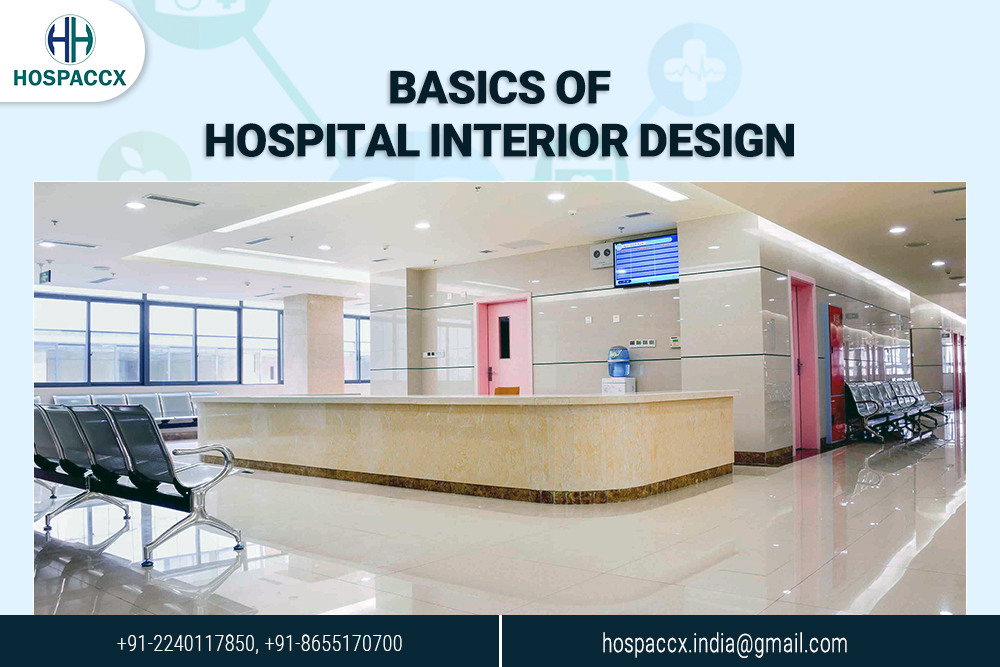Are you planning to build hospital or restructure with the latest interior designs in the hospital? Looking for basic hospital interior designs that can be used in redesigning your existing hospital? In this article Hospaccx Healthcare Consultancy has mapped all on possibilities for basics of hospital Interior design. If you need a refined market and financial feasibility or any other study related to healthcare, you can contact Hospaccx Healthcare Business Consulting Pvt. Ltd on hospaccx.india@gmail.com or you can visit our website on hospaccxconsulting.com.
INTRODUCTION
An interior designer is someone who plans, researches, coordinates, and manages such enhancement projects. Interior design may be a multifaceted profession that has conceptual development, space planning, site inspections, programming, and research, communicating with the stakeholders of a project, construction management, and execution of the planning.
Unlike other commercial establishments, hospitals are made up of several functional units, each of which has vastly different requirements and functions. By taking proper measures and precautions while designing the interior can make a hospital more comfortable, convenient, and efficient, whereas a bad interior design can impede on the proper execution of different activities. The hospital design plays a very crucial role in designing the hospitals. The hospital interior design focuses on both on the allocation and utilization of space, specifically tailoring it to the needs of the people using and occupying it. The 5 most importance of basic hospital design should be taken into consideration, they are as follows:
- Efficiency
- Sanitation
- Accessibility
- Safety
- Ambience
Utilization of proper space is very important while hospital interior design. Patients come to a clinic for treatment procedures. There are both outpatients and inpatients who get admitted for treatment. There are many other features in the hospital. They are the Emergency, different wards, pathological rooms, radio logical rooms, operation theaters and many others. All these different rooms have to be laid out in a proper manner. This can be done with hospital interior design through hospital design architecture. This results in enough space creation to carry out the entire treatment process without any difficulty. Many people prefer hospitals which have good looking interiors. Better hospital design can create a better image in the mind of the visitors. Better hospital design also results in the speed recovery of the patients. For a basic interior design of a hospital followings can be taken into consideration:
Zoning of hospital:
A high degree of asepsis should be ensured to provide an appropriate environment for staff and patients. According to Bureau of Indian Standards, there may be four well-defined zones of varying degrees of cleanliness.
- Protective zone (A): Containing mostly theatre supply, changing rooms, pre-anesthetic examination room and waiting area.
- Clean zone (B): It includes the casualty theatres, recovery wards, plaster room, theatre pack preparation and pre-operative wards.
- Aseptic or sterile zone (C): It consists of operation theatres, anesthetic and sterilizing rooms. It shall provide the highest degree of antibacterial precautions.
- Disposal or dirty zone (D): The soiled instruments and dressings are transacted through this area for washing and re-sterilization or disposal. It includes the sluice rooms and disposal corridor.
Internal Way findings:
When architecture, medical planning, interior design and environmental graphics harmoniously blend, a first-time visitor can rehearse an area without the help or “you are here” maps. Aligning the patient journey with key architecture and interior elements alleviates the necessity for excessive signage, which may become distracting. Less signage also means more room for design that makes joy and delight. For instance, bold colors or visually distinct changes at elevator banks pull people toward them. Using the concourse concept or promenade to attach departments together may be thanks to intuitively organize way finding.
Better waiting area:
The same holds true for sign up desks and waiting areas – use the spaces and their visual identities to intuitively help patients navigate. The lounge is one among the foremost stressful parts of a visit so make it a tremendous place to be: provide expansive views, windows for daylight, art and delightful, comfortable furniture. Locating waiting areas along the perimeter is efficient thanks to promote way finding and mitigate patient and family stress.
Pleasant Clinical Environment:
Patients and staff enjoy a well-designed space. While it’s tempting to focus only on lobbies and waiting areas, clinical areas need even as much attention. Imaging suites, procedure rooms where patients are conscious, and blood-draw stations enjoy natural daylight and positive distractions in art, material palette and views. These areas are critical in creating a relaxing and healing environment.
Healing Architecture:
The patients are healed with the proper architecture design of the hospital. Healing happens inside hospitals and the building itself should participate in that healing process. Designing with Red List-free materials, providing clean and filtered air, and offering accesses to outside experiences with operable windows or terraces in places where immune systems are not compromised are all strategies for healthier buildings. 10% of the ICU patients recover early through the design and healing structures.
The interior design also needs to pay due attention to the staff areas as well as the patient’s family and friends specially since a great contributor the patient recovery is the social support that he receives.
Private rooms:
The private rooms in the hospitals occupy the overall space. It reduces the overall number of patient’s beds in the given area. By providing the private rooms it reduces the infections and medication error and provides requisite privacy to the patients and his attendant or the visitors. It also contributes largely flexibility to the patients for his activity. The private rooms are well equipped with the personal washrooms, so less chance of infections.
Colour:
It plays an important role in the interior designing of hospitals and it also affects the patient’s mood. It has a therapeutic effect on his motivation and stress levels and gives him a sense of orientation. It is linked to psychological, physiological, and social reactions of citizenry, also as aesthetic and technical aspects of human-made environments. It’s been proven that insipid, monotonous environments cause sensory deprivation and are detrimental to healing. As an example, white walls have a clinical appearance and sometimes the absence of colour is unnerving and features an unfavorable effect on patients requiring to stabilize their balance or orient themselves.
Graphics:
Planners must believe design programmers that make medical building environments more humane, comforting and natural. Using effectual, environmental graphic design may be a great way to assist people relates to their space and knowledge a personalized, calm and inspirational effect instead of just a mechanical and charged hospital environment. It also helps the hospital management to convey just that to the patient and also that their wellbeing is that the hospital’s prime motive and energy.
The hospital layout should also be taken into consideration like patient waiting area, staff area, and support area. Patient area includes clinical area, patient change room, washrooms. Staff area includes nurse station, reception area, and housekeeping. Support area includes waiting area, public toilet, wheelchair stretcher, staircases, and lifts.
The following is the layout designed for outpatient department:
CONCLUSION
This study concludes that to build a basic interior design a skilled architecture is required to map all the areas. Thoughtful and inspired designers transform healthcare spaces into more humane and meaningful environments that can act as catalysts leading patients into a conscious process of inner healing and mental peace.
If you need any support in Planning and Designing a new Hospital or restructuring the existing hospital you can contact us: Hospaccx healthcare business consulting Pvt. Ltd on: hospaccx.india@gmail.com. Or you can visit our website hospaccxconsulting.com
Related Team Members




















